Even the biggest.
The closure of thousands of retail chain stores last year and this year, with many more to come – from big anchor tenants such as Macy’s to smaller stores such as Payless Shoes – and the bankruptcies and debt restructurings ricocheting through the industry are having an impact on retail malls. And mall investors – that may include your retirement account – are getting crushed.
The commercial real estate industry has been claiming that these shuttered retail spaces are being converted into restaurants or fitness centers or smaller shops or whatever. And zombie malls are leasing out their parking lots to car dealers to store their excess new vehicle inventory, and that everything is going to be fine.
But investors in publicly traded Real Estate Investment Trusts that were for years among the stars in the S&P 500 are voting with their feet.
It’s not that these REITs are doing all that badly on an operational basis. They’re hanging in there. But many of the announced store closings and bankruptcies haven’t worked their way through the pipeline.
Shares of these REITs all peaked together at the very end of July 2016 and have since then plunged in unison.
Kimco Realty Corp (KIM) says it’s “one of North America’s largest publicly traded owners and operators of open-air shopping centers,” with “interests” in 517 shopping centers with 84 million square feet of retail space in 34 states and Puerto Rico. Shares fell 2.6% to $19.42 on Monday and 13% over the past month. They’re down 40% from the peak of $32.23 at the end of July 2016:
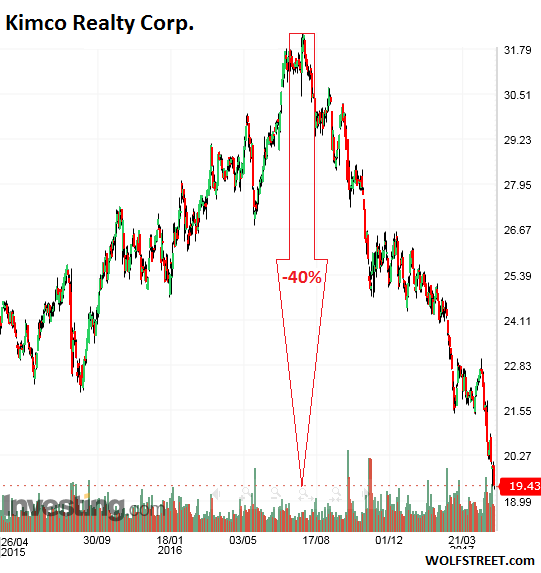
Macerich (MAC), with 54 million square feet of retail space at 48 regional shopping centers, calls itself “one of the country’s leading owners, operators and developers of major retail real estate.” It disclosed that revenues in Q1 fell 3.5% year-over-year, and that mall portfolio occupancy edged down to 94.3%, from 95.1% a year earlier.
It’s starting to feel the pain, but it’s not the end of the world. But its shares dropped 2.5% on Monday and 8.3% over the past month. They’re down 36% from the peak at the end of July, 2016:
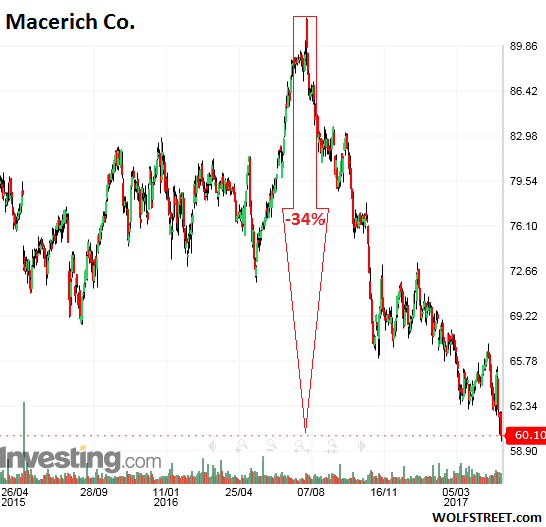
Simon Property Group (SPG), “the world largest publicly traded real estate company,” as it says, fell 1% to $162.84 on Monday and 7% over the past month. It’s down 29% since the peak at the end of July. And this despite a massive share buyback program, that included buying back 870,692 shares in Q1:
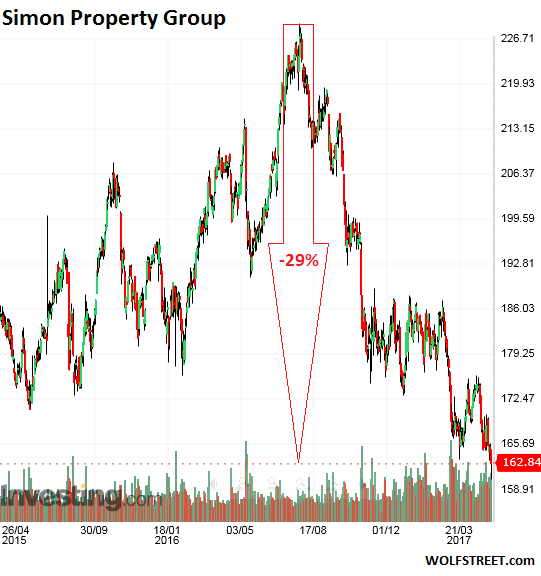
GGP, formerly General Growth Properties, is also trying to use share buybacks to prop up its share price. In Q1, it bought back 2.57 million shares for $59.6 million. Nevertheless, shares fell 12% over the past month to $22.19 as of Monday and are down 30% from the peak at the end of July:
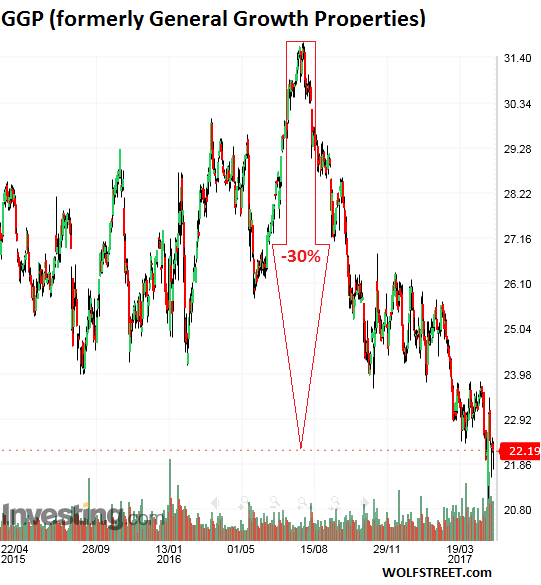
Federal Realty Investment Trust (FRT) has 98 malls with a total of 23 million square feet of retail space in “major coastal markets.” It also has over 1,800 apartments. So you gotta get creative during tough times. In its Q1 earnings report, it said:
March 28, 2017 – Federal Realty announced its exclusive partnership with Freight Farms, a Boston-based company that retrofits shipping containers with vertical farming technology capable of growing acres’ worth of produce in a fraction of the space of traditional farms. The partnership empowers anyone to use this technology while repurposing Federal Realty’s unused parking spaces as a place to locally and sustainably produce food that benefits the shopping centers’ tenants, customers, and community.
Its shares fell 1.8% on Monday and 3% over the past month. They’re down 24% from the peak at the end of July 2016:
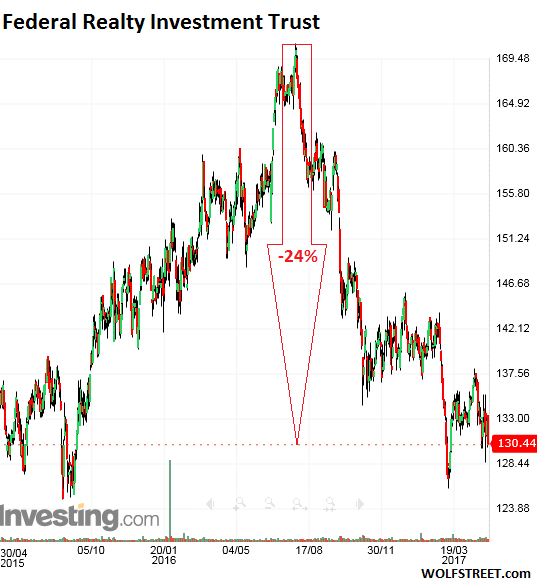
Regency Centers Corp (REG), with 429 shopping centers totaling 57.2 million square feet of retail space, focuses on “grocery-anchored retail centers located in the most attractive U.S. markets.” Its shares fell 1.9% to $61.49 on Monday and 8% over the past month. They’re down 28% from the peak at the end of July:
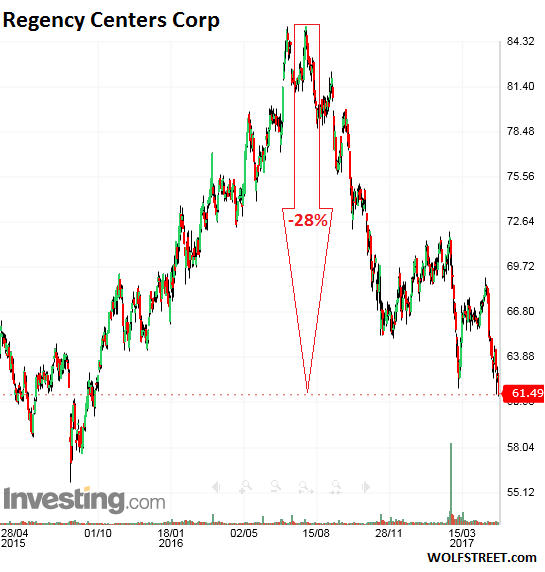
This is how the brick-and-mortar pain is translating into pain for mall-REIT investors. But why have share prices gotten crushed when, operationally, the REITs are still hanging in there and are paying fat dividends? That can best be answered by a look at the meteoric rise of those shares over the years leading up to July 2016.
Some of the share prices more than doubled over those years, as part of the commercial property bubble that got so huge that the Fed keeps publicly fretting about it, naming it as one of the reasons for raising interest rates, precisely to tamp down on the valuations. The Fed is worried that an implosion of these inflated commercial property values can take down the banks.
Mall REITs were part of this inflated commercial property universe, and they soared with it. That entire universe is now peaking. But separately, mall REITs are also caught up in the relentless brick-and-mortar retail meltdown, as online shopping is taking over. This is a structural shift that will continue to progress. Mall owners are already trying to find a way to “repurpose” their malls. But this isn’t going to be smooth.
As so many times, Private Equity firms are in the thick of it. Read… I’m in Awe of How Fast Brick-and-Mortar Retail is Melting Down
Enjoy reading WOLF STREET and want to support it? You can donate. I appreciate it immensely. Click on the mug to find out how:
![]()


My local mall needs money so bad they have a carnival here this week.
I went to one in our downtown and saw a movie a couple of months ago. Parked in the massive structure by myself. Saw a movie (Get Out) nearly by myself. Validated my parking in one of the only open stores (JCPenny, believe it or not), and the only other people in there were validating parking.
As I was walking back to the car, I noticed that the only “open” mall shops were what used to be the island vendors! The mall probably put them up in a store front for no extra charge!
There are two large malls near me, Eastridge and Valley Fair, one’s on the #22 bus line and the other’s right on the #23, but so far I’ve managed to avoid going to either one.
There’s a big creepy “ghost mall” in Cupertino, which is ostensibly a wealthy town but apparently not wealthy enough to support a mall.
‘The Fed is worried that an implosion of these inflated commercial property values can take down the banks.’
This is why I think the Fed may have to step back from all its hints about tightening. True, it would be tough to not do .25 in June after virtually telling us it was going to- it has to cling to some shred of toughness and credibility.
But with the condo bubble also in the process of bursting, that may be it instead of the expected three hikes in 2017.
If everything is correcting as it should, except some of these stock market high flyers like social media, (Dot.com. 2 ) could the Fed try to throttle them back with a more focused instrument, e.g., margin requirements or suasion about these stocks being used as collateral for bank loans?
Time to cut wages/benefits some more…
And cut taxes on the rich! Solves all problems.
Yellen has no intention of tightening. At the June FOMC meeting she will once again pull her played out “Lucy and the football” routine of finding some lame reason to defer a rate hike. Bilking savers out of interest income is too lucrative a racket to relinquish voluntarily.
There are multiple malls I’ve seen where this is not the case. Valley Fair(San Jose) and the Great Mall(Milpitas), which are both packed on the weekend and you rarely see empty store fronts in their complex. Although this is Silicon Valley, the one commonality I’ve noticed is that the majority of customers are foreigners. (You possibly could debate the Great Mall given the ethnicity of the locals around it, but I rarely hear English spoken). So the locals are not spending, but the foreigners are enjoying American commercialism.
My wife and daughter-in-law, both Chinese immigrants, frequent these two malls, and, for reasons I don’t understand, seem to have no interest in the many other malls in the area. They do this usually with no specific purchase in mind, but as a leisure activity they both enjoy, and never buy anything that isn’t marked-down. You bet they’re enjoying American commercialism! Back in China, my wife would go window shopping looking at even things like a piece of fruit she couldn’t afford.
“Locals” in California speak English; Who knew?
number1gi – As has been noted, “there’s no ‘there’ there”.
California has become a place you go to make money, not a place to have any kind of community. As a native English speaker, I’m in a definite minority. Not one who gets rocks thrown at them like in Hawaii where I grew up, so it’s much nicer here, but there’s no sense of history or of place.
I think money is the biggest, or at least one of the most important concerns for most people as they wake up everyday. Certainly for me, as it acts as the motivation to fight traffic and go to work. In fact, almost every post of wolf himself is tangentially related to money, in some form or another. So California seems to be a fine place.
I think we should not compare general US malls situation with SF Bay area (especially south bay). That is because a lot of big stores & malls are being converted into residential/mixed use area, while the inflow of people is high. Vallaco park mall, Kohls stores in Santa Clara & San Jose are all gone leaving just Valley Fair & Great Mall in south bay.
And the recently expanded Stanford Shopping Center.
Don’t compare it. Silicon valley and Entire SF Bay Area is like living in a different country.
Things are just peachy here. everybody has a new fancy car, 2K tiny apartments, 800K starter home shacks…but every mall and restaurant is packed full. You gotta fight for a spot out in the parking lot. $12 burritos and burgers. Money and homeless everywhere.
I also believe that that shops and Malls are packed because there are a lot people who are:
1. Single
2. Overworked or workaholics
3. huge transient and melting pot place (difficult to make friends and cultivate social relations)
4. Lonely people
5. keeping up with Jones
6. …
It’s well know that people shop to feel better about themselves, some are lonely others are depressed, many are just dumb… just trying to numb it.
I had female co-worker who was divorced, 40 years old, overweight, who had a dog, no friends or family around, she would shop every weekend at different malls. She had a lot CC debt, plus school loans, but she could Not stop buying shite she didn’t need. (it was therapy)
Many people in Silicon Valley don’t realize the bubble they live in. Even family out in the nice part of Sacramento have never visited Fresno or Bakersfield and have no idea the condition of the rest of the US. They live in blissful ignorance as do most of these mall visitors.
From my few visits, most of the mall traffic is geared towards “ft’s” wife and daughter in-law. The majority of foot traffic in Valley Fair are asian woman and teenagers and about 1/2 that in the Great Mall. The other 1/2 being Indian families. You might be right that the big buyers are mostly lonely, older woman, but my general consensus is that the biggest foot track is from big salary family of immigrants.
I agree that as a single American male, Silicon Valley is a lonely place. Constantly treated like a foreigner here… and melting pot is what American’s say, but not what foreigners believe.
Having lived many years as a lonely single American male in Silicon Valley, I finally admitted that the problem was me, not the valley, and did something about it.
Immigrants are not all rich. Majority are waiters, beauticians, truck drivers, grocery store clerks, etc, struggling to make the rent just like anyone else. Many are naturalized citizens and their children are natural born citizens.
Immigrants are here to stay. They are part of the landscape. They are not going away. I am not always comfortable with that; sometimes I would prefer that the valley revert back to 1967. But that’s not how life works.
Within a block of my modest vintage 1942 Sunnyvale tract home are five other mixed American/Asian households, a growing trend. We are the future. Get used to it. Go give your best smile to one of those young Chinese women at Valley Fair and ask if she can direct you to the Hawaiian jewelry store or something.
Ehawk – well put. Tons of money, Teslas everywhere, but also literally about 10,000 people living on the street in Santa Clara County.
We’re becoming a country of the few rich, the many poor, and the middle is being hollowed out.
No sense of this being “home” not even to people who were born here.
1. I lived in CA for 20 years and have had family there for >100 years. It’s not what it used to be. (I have two college degrees from the place.)
2. As I have posted before, adjusting for cost of living, CA has the highest percentage of poor people. Again, it’s not what it used to be.
California? Now, a very strange place. If you weren’t there before ~ 1990, you don’t know what the previous California was (when it was really the best place in the world, as in ~1945-1975 plus or minus a decade or so.)
Today it barely has an American culture or economy.
You left out the 2 big reasons people who don’t spend go to the mall food courts, library’s Etc, in the winter they are warm and in the summer they are cool.
I know people who walk around a big mall complex 3 or 4 times, as an exercise routine, and never spend a cent there, everyday.
Great comment. Totally true about shopping. It’s a sad empty life one has if their leasure time is spent in malls aimlessly buying stuff. Sadly, many people have that sort of life. Mouse spinning that wheel…
Santana Row and Stanford Shopping center have lovely outdoor, park-like areas. They almost feel like they have a social scene (Santana Row more so). That could be attracting people. Many indoor malls are bland and almost embarrassing/depressing by comparison.
Same in SoCal, all the Westfield malls here are packed. I dropped into an Apple Store in the mall – bad idea, no open appointments for two days, and even with an appointment, wait time of 45 min. You do see vacancies in smaller / older strip malls though.
LOL! Go to the Horton Plaza in downtown San Diego… it’s a Westfield that will give you idea of what this blog is talking about.
– June 2016 was around the time the US 10 year yield bottomed. Seems stock investors thought that falling rates would save the “rear end” of those mall investment companies.
– Do you have any number on how much credit has been taken out to finance commercial real estate and how much credit is at stake/in danger when these malls go “belly up” ?
I have tried to find these numbers (e.g. FRED) but to no avail.
– Recently I heard that the amount of banks “in trouble” has risen from ~ 450 (???) to ~ 520 (???) ? This is also something I tried to find data for (to no avail). I tried to search FRED but (again) to no avail.
– It seems that regional banks have lent (heavily) for this kind of (commercial) RE ???
– In Canada another RE company is so deep in trouble that it filed for “Creditor Protection”.
https://jugglingdynamite.com/2017/05/04/one-of-canadas-largest-realty-investment-cos-files-for-creditor-protection/
(Love to visit this website regularly. It has from time to time very critical articles. Just dig a little deeper than the FrontPage of this website)
It is amazing, how little is being reported about this; guess they learned from all the coverage of the previous ‘problem’ and what panic it Had caused.
… and yet …. and yet … in Greenwood Village CO a developer is currently lobbying for all he’s worth mandating a special election this month to build yet another ‘ mega ‘ mall in the Metro Denver area twice the side of one of our largest [ Park Meadows ] despite the fact that every current mega mall in the metro area is riddled with vacancies
Honestly .. either where’s the logic … or what are these people on ? That is the question enquiring minds want to know .
Part of it is how cheap retail is to build. The tenant leasing a new small unit gets a concrete floor, a roof and four walls. There is no individual plumbing, windows or doors, apart from the metal shutters that close the store. Someone more familiar with this may have an actual number but 15-20 bucks a foot is what I guess.
If the unit remains leased I’m sure it is far more profitable than residential, and with almost none of the tenant headaches or legal complications of a residential tenancy.
That may apply in some cases but in this case Greenwood Village is a very affluent area directly connected to Cherry Hills ( home of the upper 1% and .1% in Denver ) and Denver Tech with the mall in question being of the premium kind mandating a myriad of luxuries etc in order to entice both those living here as well as attracting customers from across the metro area in direct competition with the likes of Cherry Creek Mall , Downtown etc . e.g. This baby’s gonna be anything but cheap . As an example have a look at Kuni Lexus Greenwood Village that is just up the road from the proposed mall . That .. is the standard this proposed mall must either meet or exceed if it hopes to succeed in this neighborhood and against the metro area competition its placing itself up against .
Thank you for another reminder of why I left Colorado.
rx
The mills of the gods grind slowly…
The malls and gigantic chains killed the local owner/operator stores on main street in the 1950s and 1960s. It is now their turn.
….. fingers crossed and here’s hoping .
I mentioned this before.
Our local mall has just a few stores left. Mostly, it has been converted to indoor rv and boat storage. It is now called ‘a commons’. The dollars store seems pretty busy, though. :-)
Mostly, the local WalMart, and a few other mega chain stores built on native land (to avoid taxation and development fees) are what has killed off the mall and downtown shopping.
WalMart shopping….an experience to avoid at all costs. (Pun intended). I did notice they have an indoor Mc Dees at WalMart….. full of three hundred pound customers buying breakfast at 10:30…people in their 30s with little kids, children obviously not in school or parents working. This is urban Canada of the modern era.
Well, at least you are still behind the States. The next step is they’ll be showing up in their pajamas. More comfortable and stretchy around the ample mid-drift you know.
Had an early morning flight recently and saw a whole family eating fried chicken for breakfast. I may never be able to eat fried chicken ever again, for any meal.
Made me think of my last trip to Japan – there’s a lot of fast food in Japan as well, but no “fast food smell” whereas here you can smell a fast food place from a mile away! Airports are the worst!
I think it’s the rancid oils. yuk.
New day. There done. For 25 years people have been looking for alternative uses for the space.
David, yeah, they should convert them to condos of some kind. Just keep the dollar stores, though–they seem to be thriving.
Wait till the balloon debt is due for rollover and the lenders will cut back on credit.
My relatively small suburb just approved 2 new developmnets-1 small but contianing a competitor to HD and LOW all of which are within a mile of each other over constituent disapproval but teh incubant was reelected which shows you soething.
The other development is mixed use with the anchor Whole Foods–on the parcel that the Village bOrd said was the last big great plot of land avaiable in town. So with that -the boad granted the developer a 21 million dolalr low interest loan to do the project and sales and property tax concessions.
elected leaders are dumb. They have leverage and have no clue how to use it and part of that is it is not their money.
My town is soon to have plenty of vacant space. Probably starting with the current lowes location which is walking distance from the new big box hardware store.
The issue is People with smarts and good experience do not want to do the job.
“The issue is People with smarts and good experience do not want to do the job.”
NO
The issue is People with smarts and good experience are prevented from getting the job by the corrupt cronies in control.
Or if the do manage to get the job are prevented from achieving anything by the by the corrupt cronies in control.
An example eof this can be found in italy.
Every city where 5 start politicians have taken control, the corrupt cronies have stymied them at any and opportunity. One of the more famous being this one
https://www.theguardian.com/world/2016/jun/11/rome-mayoral-elections-raggi-corruption-five-star-movement
Where the mafia control the garbage industry and want her GONE.
She got the Job, and the corrupt cronies are deliberately making her look stupid.
And America, runs in an eerily similar way. Particularly in Democrat controlled City’s/States. Detroit, Chicago, Etc.
Some forecasters saw it coming in time to avoid investors being “demolished”:
https://www.forbes.com/sites/timworstall/2013/01/01/the-coming-death-of-the-american-shopping-mall/#1142655d2a11
on the leverage issue–then what happens when rates go up?
It’s commercial lending, not residential. Those loans don’t go adjustable at the end of the fixed term, they come due. Interest rates are the least of their worries. It’s refi or pay off!
I’m pretty certain these malls aren’t going to pay off all of these notes, even if they could… think strategic walk-aways, like what happened in the 2008-2012.
If Westfield goes under, who’s left to buy a ton of malls from the bank?
A better question: who is Westfield’s lender? Glad I’m not!
Indeed. Some of this debt is in commercial mortgage backed securities (CMBS) with 10-year maturities.
About $30 billion of retail-based CMBS will mature (or already has) in 2017. And a bunch more next next year. Fitch is getting nervous about them.
Westfield go under?
Well its possible, but I doubt it.
Westfield used to be an ‘all Australian’ company until it was split into two parts: Australian assets and everything else. That was in 2014.
Maybe they were on to something way back then!
Should Westfield go belly up then I would think that the Australian company would swoop in and buy the company back at a nice price.
Right now I’d be more worried about the Australian malls as we are going to be in world of hurt over the next couple of years with the economy for everyday, ordinary Australians is slowly coming apart.
Amazon is coming later this year and that will have a huge impact on retail here as well.
The government announced the next budget last night budget and basically it gives away to two groups: people with kids as they are going to spend another A$37 billion – yes billion on childcare and companies who will get a A$24billion tax cut over the next several years.
(Why in the world do people making A$300,000 year need a bunch of assistance so that they can send their kids to daycare???)
Oh, yeah people on pensions managed to get a A$75 one-off payment for soaring electricity prices………..
A A$200 million sop compared to the other $50 billion plus to the ‘special groups’.
And finally, yes the government here is going after the despised foreign buyer of real estate by putting more taxes on them and limiting purchases.
I’d be watching the level of immigration closely over the next year to see what happens with the numbers.
A budget based on BS projections and the continual give away to special groups.
Not happy Jan.
I am increasingly more aware of auto, mall,restaurant and retail businesses, in general, going south. Whats next?
Whole Paycheck. Maybe even normal grocery stores? Here in SoCal there’s a chain called Bristol Farms that is even more expensive than Whole Foods. Recently, they started sending coupons, first time I’ve ever seen them do that. But their coupons are a joke, still 2-10x more than Aldi where I don’t have to deal with coupons. We barely go to normal supermarkets now, Aldi and Trader Joe’s have us covered.
I shop at Sprouts… cheap, natural and organic options. Like Whole Foods without the snobbery.
Oh man, I forgot about Bristol Farms. I had a wealthy friend who used to shop there, and it is certainly shocking. I can’t believe they’re actually doing coupons.
What you don’t understand it that many of the ‘born and bred’ upper 20% have a genuine fear for the lower 80%. Not just fear, but a sense of disgust that comes from the thought that these people ‘made the wrong decisions not to be well off ‘ and hence you can’t even rub shoulders with them.
They are the ‘untouchables’, in the 20% caste system.
Bad luck rubs off.
The people who shop at whole foods or red plum or any of these other crazy priced chains do so in order to express upper class distate for their economic inferiors.
I am always shocked when one of my multi-generational upper 20% friends ( with trust funds and vacation homes) says they would never shop at Vons or Ralphs because of the ‘kind’ of people who shop there. And Walmart would like be a descent into hell itself!
I suggest opening a chain whose goods are ten times the price of whole foods. I promise you the place will be packed by ‘the right kind of people’.
I know people making min wage who shop at Whole Foods, and people with trust funds who shop at Aldi and Walmart.
Regardless of your income level, shopping at Walmart *IS* like a descent into hell. :-)
Meanwhile in upstate New York
“Store closings: Retail wreckage in CNY and beyond in 2016-2017”
http://www.syracuse.com/news/index.ssf/2017/05/stores_weve_said_goodbye_to.html#incart_m-rpt-1
Dying mall should be converted to mini + micro apartments plus
food court & entertainment + pubilc transportation.
The malls will become a village, housing low income people, or
the elderly. Hundreds of unit without too much investment.
It will be safe and much cheaper than other options.
The inverse of the last decade macmansions.
Be careful what you wish for.
You might get it.
https://duckduckgo.com/?q=detroit+housinghttps://duckduckgo.com/?q=detroit+housing+project+ruins&t=ffab&iar=images&iax=1&ia=images&+project+ruins&t=ffab&iar=images&iax=1&ia=images&
I believe conversion into things such as housing for the elderly would be ideal. Lots of covered large sq.ft. per story space with common area for sharing…what is not to like. And as Michael points out, without too much more investment.
Conversion to residences impractical due to plumbing requirements, especially for elderly.
Except possibly for emergency/ or literal homeless and this comes with BIG administrative issues.
In my town a large mall is 80 percent empty, with a Sears as one of the two anchors, and we know how long that is likely to last.
We also have a university that is constantly expanding, opening new locations, building, etc. at great cost.
I see the mall’s alternate use as closest to an educational institution.
My little burg has one old mall and a brand new one under construction. The old one is actually named “Sears Town Mall” and has one anchor: Sears. The place is ghostly dead and the kids use it for skateboarding.
Sears is so screwed they are not even trying to get into the new mall. I’m guessing they’ll just die along with the old mall. And to add to the level of patheticism (new word, feel free to use), one of the anchors at the new mall is Hobby Lobby. Plus the new mall will have set of doctors offices, a movie theater, and a Harley dealership.
I’ll watch movies and fondle the Harleys. Much of the rest is a retail nightmare.
New mall under construction? Very foolish investors evidently given the signs
There are two economies in America. Those in the ‘system’ and making money and those outside losing their ass. Depending on where the mall is located, it thrives or stagnates.
I live in Charlotte NC (soon to leave). Several malls doing poorly. One high end mall doing fine.
@Mike R. – Hello neighbor.
And your assessment of two economies is spot-on.
I would add as a corollary that most of those in the “system” are blissfully ignorant of those outside, whether intentionally or unintentionally.
Do not demolish those malls just yet. They can be remodeled in many different ways, and can be used as future homeless shelters when the SHTF. Kind of like the grand train and bus stations of the past.
The central planning bank can print the money for it.
Or like the superdome in the wake of Katrina??? No thanks. No FEMA campt for me.
Malls can become medical clinics for independent doctors. No need to build those fancy and overly expensive hospitals and specialized medical buildings. Easy access, wheelchair and handicap ready, and lots of room for benches to sit on.
Probably nitpicking on Kimco but if it’s lost 12.80 of 32.23 that isn’t 66%. I get something more like 40%.
Thanks. You’re correct. 39.7% – so 40% not 66%. I’ll blame a Fat Finger or the weather.
malls suck.
if you want to go to one store, you might have to traverse the entirety of that universe.
who wants to walk a half mile when, with stand alone store, you might be able to park right out front.
i was in the galleria mall in houston some months ago. on a saturday to pick up a customer at one of the hotels.
no one is buying anything. they are all just there to socialize. and most of them from the indian subcontinent.
very weird.
this is what bezos saw. that very few wanted that experience if they had a purchasing target.
they didn’t want to deal with the parking expenses. the walking efforts to purchase a pair of sunglasses.
when they could get on amazon and have them delivered within a couple of days with no parking, no walking efforts.
all things considered, the purchasing class hates malls.
Every mall, dying but not dead yet, have dozens of workers. Their biggest expense is housing and their used car.
Mall have satellites : free standing stores. It used to be a must have fad, every businessman wanted it until 10 years ago. Now, many are empty, completely abandoned.
Mall mgt. should cut cost by offering workers, from the mall, or nearby, an almost “free rent”in those satellite free standing stores.
Start in few small steps. Small living spaces with central bathrooms, central kitchen, just dump the empty showcases
and convert these locations into dozens micro living units.
It’s a win win for workers that will cut the cost of housing by a huge
margin, and the need for a car, that can cost hundreds of dollars per
month. Food, entertainment and liquor few steps away.
Those free standing stores can be a “new” solution for the cost of
housing & transportation.
Instead of looking for a tenant for sublease, cut the cost of labor by providing some workforce shelter.
Business will have a better chance to survive the next downturn and
the authority might ignore the illegal aspect, to be an obstacle and make
life harder for both workers and owners.
Owners will not just “save cost” tremendously, they will have a a huge
power on workers life and fate.
This is the Chinese model used by Foxxcon etc. – the workers are in dorms or in small rooms with shared kitchens, bathrooms etc.
Of course all Chinese in this situation will be young and anxious to move up, but it is better than field work back in the village. Dorm living needs a level of discipline there you couldn’t enforce here.
There would be too much stigma attached to this for your typical US mall employee or at least the ones you want- the mall would also get an absolute hammering in the media: ‘Why don’t you pay a living wage with full time hours instead of creating a ghetto?”
I love the idea of converting dead space, but going from the above model to creating micro- apartments is a big one. The reason many budget apartments and hotels and (even not so budget) in Europe today don’t have their own bathrooms is because this is the biggest expense in a conversion.
I’ve jack- hammered a couple of basement floors doing this.
So what happened in July 2016 that caused the concomitant fall of these companies share prices? The article does not address this.
Maybe some people read this (published May 17, 2016)?
http://wolfstreet.com/2016/05/17/mall-owners-reit-feel-pain-of-brick-mortar-retailers/
Just kidding. That malls would get hit isn’t new. It just took stock jockeys a while to accept it. Bubble mood reigns. So bad news can be blocked from the collective consciousness for years.
After that it’s the herd.
Physical retail aka pushy salespeople, lousy selection and prices, terrible customers, parking problems, crime etc = so much fun! (not).
Heck, I don’t bother even bother showrooming stuff in shops anymore since Youtube is already better for that. And it doesn’t cost me a car trip either.
I wonder why whole foods has the snooty reputation, the people are nice in there, they even give away free samples on Saturdays
As for the malls people are not healthy enough to walk from one store to another let alone one end to the other and back to their car.
Mayor Chris Beutler and officials with SouthPointe Pavilions and Scheels today announced that the sporting goods retailer will invest about $84 million in a new larger store and other improvements at the south Lincoln shopping center.
The new Lincoln store will be modeled after the flagship store in Overland Park, Kansas that opened in June and includes a Ferris wheel, aquarium, sports simulators and an exhibit on U.S. Presidents.
To be fair, Lincoln, NE is the new “Silicon Prairie” with rents skyrocketing downtown and young people pouring into town on P&M’s dime. Unsustainable as I see it. The dot-com 2.0 is coming along with the student loan bubble going off also.
Scheel’s mentioned above is basking in the UnderArmour/North Face craze for now, but sporting goods will take a pounding like golf has. I wish them well, but I shop at Sears because I know a fleece costs $12 not $120.